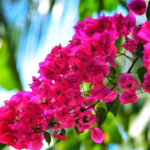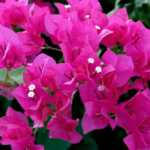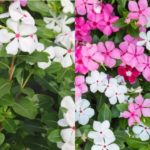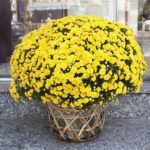Bougainvillea is a type of flower that has a simple beauty, also known as Paper Flower or Bougainvillea spectabilis. It belongs to the Nyctaginaceae plant family. The name of this flower is based on its outer characteristics, which are delicate yet resilient, as it can withstand drought and bloom year-round. Additionally, the flower petals resemble delicate, thin sheets of paper.
According to research, bougainvillea originated in Brazil (South America) and later spread to other countries, especially those with tropical climates. In our country, which also has a tropical climate, bougainvillea is easy to grow and can be found in many places for landscaping and providing shade (as a trellis for climbers),…
Bougainvillea is a woody vine-like plant that can grow quickly with many branches and thorns. The leaves are dark green (evergreen), shaped like ovals (tapering at the top and round or slightly curved at the base), and arranged alternately.
Bougainvillea flowers are clustered at the ends of branches, and although they come in many colors, they are actually bracts (modified leaves) that create the colorful appearance. The actual flowers are small, tube-like and usually white or slightly yellow, hidden inside the bracts. The fruit of the bougainvillea is rarely seen, but it is round and brown.
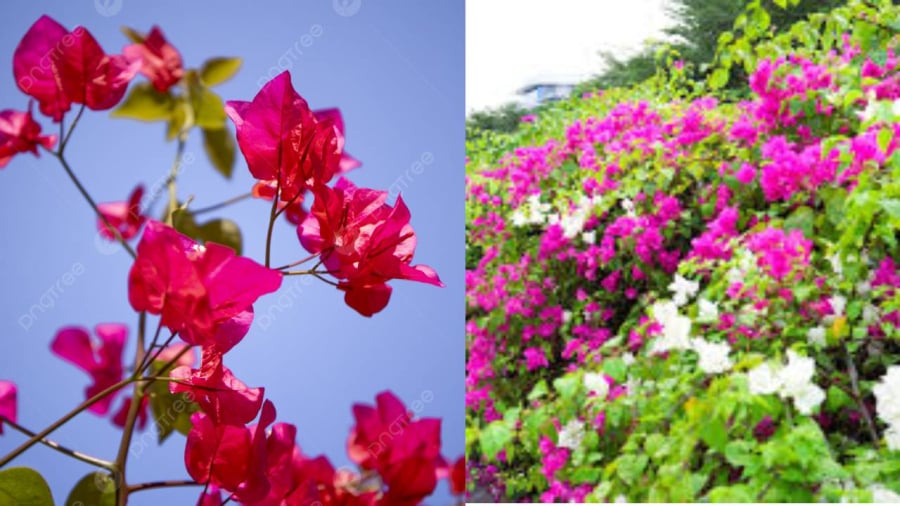
How to Water Bougainvillea
First and foremost, you need to understand how to water bougainvillea properly to prevent over-watering. Bougainvillea does not tolerate excessive water, so it is best to plant it in a dry, well-drained location to avoid waterlogging. It is recommended to create drainage holes in the pot or container to prevent root rot or waterlogging.
When watering bougainvillea, you should avoid excessive watering, as this can lead to root rot and plant death. Additionally, you can use a sprayer to evenly distribute water to the plant.
For newly planted bougainvillea, you should maintain moisture for about the first 15 days, so it is recommended to water once a day. In addition, you should provide shade for young bougainvillea plants to ensure optimal growth. Over-watering can lead to plant death, while under-watering can result in fewer flowers. After approximately 15 days, when the bougainvillea has established stable growth, you can water it 3-4 times a week.
During sunny seasons, you only need to water bougainvillea 3-4 times a week to maintain moisture. Bougainvillea does not require a lot of water, so it is important not to overwater, as it can affect the plant’s growth. When bougainvillea is in the flowering period, it is important to maintain moisture to ensure even and beautiful blooming.
How to Encourage Bougainvillea to Bloom
You can start fertilizing bougainvillea by mixing fertilizer with water and watering the plant at the beginning of spring and every 2 weeks during the flowering period.
Bougainvillea is relatively easy to care for. During summer, when temperatures and humidity are high, you should pay slightly more attention. Maintain a loose, well-drained soil and regularly supplement with 3 essential nutrients: nitrogen, phosphorus, and potassium for optimal bougainvillea growth.
You can consider using flower-boosting fertilizers such as Amino Acid, Atonik, or Na-NAA.
Another interesting tip to maintain the soil’s pH is to use vinegar. Mix 1 cup of vinegar (150ml) with 4 liters of clean water and pour it into the soil. This solution helps increase soil acidity and provides a certain amount of iron to the plants. Vinegar stimulates healthy plant growth and regular blooming.
How to Control Watering to Promote Bougainvillea Blooming
It is important to note that bougainvillea thrives in dry soil conditions, which leads to more flowers and overall better growth. Therefore, if you are growing bougainvillea at home and want it to bloom at the right time, you can control watering. Stop watering the plant for about 50 days, and do not worry about the plant dying, as bougainvillea has excellent drought tolerance.
Afterward, you can resume regular watering for about 10 days to promote vigorous growth and beautiful blooms. For a pot with a diameter of 25cm and depth of 23cm, you may water it with 200ml per day. Additionally, you should supplement the plant with appropriate fertilizers to encourage more abundant flowering!
Popular Varieties of Bougainvillea
Thai Bougainvillea (Bougainvillea Spectabilis)
Distinctive features include two colors (pink and white clusters), minimal shedding, and regular blooming with small petals. This type of bougainvillea can be propagated from cuttings and is often planted as an ornamental plant in front of houses.
Brazilian Bougainvillea (Bougainvillea Glabra)
Characterized by its ability to grow as a climber on various surfaces (gates, walls, etc.) and possessing the aforementioned characteristics of bougainvillea, such as dark green leaves, oval shape with a pointed tip, clustered flowers, etc.
Vạn Hoa Lầu Bougainvillea
Commonly found in pink-purple or pink-red colors, it is a relatively small plant and is often grown in pots as a bonsai.
Cao Bồ Bougainvillea
This type of bougainvillea is impressive as it naturally produces many colors (red, orange, white), not through grafting. It is characterized by small leaves, green in the middle, and silver-white around the edges, slightly rounded.
Cẩm Thạch Bougainvillea

























